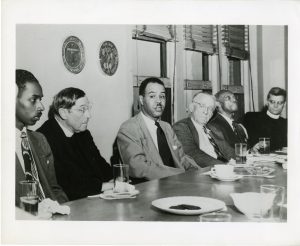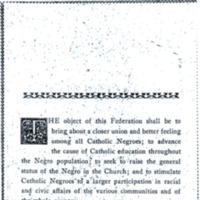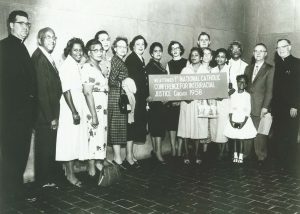Father John LaFarge, Jr., S.J., a founder of the Catholic Interracial Council of New York, was one of Catholic America’s leading intellects during the first half of the twentieth century. He wrote and edited for the Jesuit weekly, America, for 37 years, wrote and published hundreds of articles and eleven books, co-wrote an encyclical, Humani generis unitas at the request of Pope Pius XI, and worked relentlessly, if not always successfully, to improve the circumstances of African Americans within the Catholic Church.

Though LaFarge titled his 1954 autobiography after the Jesuit Rules, The Manner is Ordinary, his early life was anything but average. Born in 1880 in Newport, Rhode Island to the well-known nineteenth century painter John LaFarge, and Margaret Perry LaFarge, a descendant of Benjamin Franklin and Naval Commander Oliver Hazard Perry, LaFarge enjoyed a privileged boyhood. Though he decided to become a priest at 12 years of age, he attended public schools in Newport, and graduated from Harvard University in 1901. He revealed his desire to become a Jesuit just before his ordination at the Seminary at Innsbruck, Austria. During his Jesuit[1] training, he spent time as a prison chaplain on Blackwell’s Island (Now called Roosevelt Island) in New York City. Of his experience there, he wrote, “Innsbruck and Woodstock [Seminary] were schools of knowledge, but Blackwell’s Island was a school of life and death.”
At Blackwell’s Island, he came into contact with large numbers of African American and impoverished people, and was impacted deeply enough by the experience to make civil rights the focus of his life’s work. His assignment to the Jesuit missions in St. Mary’s County in Southern Maryland from 1911-1926 saw his commitment to the African American Catholic population deepen, even as it became fraught with controversy.

In fact, the African American Catholic community in the United States was small in the early twentieth century, hovering around 200,000 from the late nineteenth century to the early 1930s. Additionally, as historian Cyprian Davis, O.S.B., recounts, that population suffered from a lack of representation by Blacks among bishops, priests, and both male and female religious. Though African Americans sought to enter the priesthood and religious orders, their numbers remained extremely low due to racism within the church. Davis notes that the Black Catholic laity sought to fill the vacuum of leadership within the church, with several Black Catholic lay congresses organized by Daniel Rudd in the late nineteenth century, and the Federated Colored Catholics (FCC) organized by Thomas Wyatt Turner in the twentieth century.[2]
The leadership vacuum, however, would have a profound impact on how white priests like Father LaFarge interacted with the African American Catholics he sought to serve. LaFarge and Turner saw the role of black lay Catholics within the church differently. The FCC was founded in 1924 by Turner and several Black Catholic laymen who sought to address the absence of African-American clergy, the discriminatory practices of the Josephites and Catholic Universities, and the need for greater African-American representation on the boards of various Catholic welfare organizations. Father LaFarge served as an advisor to the group, but in the end they parted ways, as Turner sought educational equality among white and black Catholics within Catholic institutions, accepted lay organizations, and access to the priesthood. LaFarge, while denouncing racism and supporting a black Catholic apostolate, favored emphasis on integration and interracial cooperation.[3]
LaFarge also served as chairman of the executive board for the Cardinal Gibbons Institute, a Catholic school established in southern Maryland in 1924 for African American students. While the school served as an early endeavor to address the educational inequities within the church, LaFarge clashed with the school’s principals, Victor and Constance Daniel, over many of the same issues with which he disagreed with Turner, and the school closed in 1933.

Such experiences nonetheless informed LaFarge’s next venture, the founding of the Catholic Interracial Council of New York (CICNY) in 1934. By this time, he was well known as an informed clerical voice on racial issues in the United States, having written many articles on the topic for America, where he had served as assistant editor since 1926. The CICNY functioned under the auspices of the Archdiocese of New York City. Catholic social teachings and American democracy formed its underlying principles. LaFarge served as the CICNY’s chaplain, primary theorist, and guiding light from its founding in 1934 until he retired in 1962. George Hunton, who had been the secretary of the executive council of the Cardinal Gibbons Institute, served as the CICNY’s executive-secretary from its founding in 1934 until 1962. Hunton oversaw the daily business in the CICNY offices and served as the editor for its monthly journal, Interracial Review. Hunton and LaFarge, who for almost 30 years were the prime movers and visible representatives of the CICNY, were joined by Gerard Carroll, long time chair of the CICNY Board of Directors, in making the CICNY a stable and active organization that, despite its regional name and jurisdiction, possessed a national reach and profile. From meetings, intercollegiate conferences, and the publications disseminated through the organization’s Interracial Review, the CICNY influenced progressive thinking on racial among Catholics, especially in the 1930s and 40s, and formed the underpinnings of Catholic approaches to the civil rights movement in the post-World War Two period.
The records of the Catholic Interracial Council of New York are housed at the archives.
[1] David Southern, John LaFarge and the Limits of Catholic Interracialism, 1911-1963 (Baton Rouge: Louisiana State University Press), 22-23; Robert Hecht, “John LaFarge,” in Michael Glazier and Thomas J. Shelley, eds., The Encyclopedia of American Catholic History (Collegeville, MN: The Liturgical Press, 1997), 790.
[2] Cyprian Davis, The History of Black Catholics in the United States (New York: Crossroad Publishing, 1992. See also, Davis, “African American Catholics,” Glazier and Shelley, Encyclopedia of American Catholic History, 10.
[3] Southern, LaFarge, chapter 5.

In the first photo, George Hunton is to Roy Wilkins’ left. While I was doing graduate work at Fordham, Phil Hurley, S.J., offered me a part-time job, going down to the CIC a couple afternoons a week to help put the Interracial Review together. But it was mainly to keep an eye out for supposedly retired Hunton, seeing that he didn’t come into the office while he was supposed to be writing his history of the CIC. Before taking the job, I was sent to visit Fr. LaFarge at the Jesuit residence. I went up to his small room with a bed, a writing table and chair, and what seemed to me to be Navy surplus bedside table. Fr. LaFarge seated himself on the bed, pulled out the scratchy drawer of the metal table and produced a well-opened half-empty pack of Lucky Strikes to offer me a cigarette. I declined and we chatted a bit and then I left, LaFarge apparently satisfied that I wouldn’t do any great harm to the movement. I left, knowing that I had been in the presence of a saint. I treasure that encounter to this day.